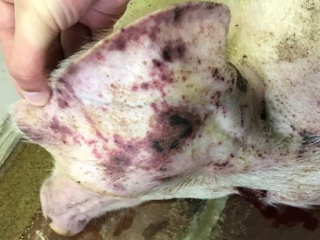| The WA Livestock Disease Outlook provides information about recent livestock disease cases in Western Australia and diseases likely to occur in the next month. Calling a vet to investigate diseases when they occur provides surveillance evidence to our markets that we are free of reportable and trade-sensitive diseases. |
Recent livestock disease cases in WA
Exotic diseases (including African swine fever) ruled out in grower pig
- One male grower pig from a line of 360 was down and noticed to have red blotchy lesions on the ear and leg (see Image 1).
- The pig was euthanased and samples from a post-mortem were submitted to DPIRD for analysis.
- Porcine dermatopathy and nephropathy syndrome (PDNS) was diagnosed.
- PDNS is associated with infection with the virus porcine circovirus. This virus is present in many herds without causing disease until pigs are stressed by environmental or management factors, or are unwell with another infection.
- As the disease signs shown were similar to those of the exotic diseases African swine fever (ASF), classical swine fever and porcine reproductive and respiratory syndrome, testing was carried out to successfully rule out these diseases.
- ASF is currently spreading across Europe and Asia and poses a major threat to pig-producing countries that are free of the disease, such as Australia. Calling a vet to investigate cases such as this one for reportable diseases helps to demonstrate WA’s and Australia’s freedom from these diseases, which gives us a market advantage and allows us to export pig products widely.
- If you suspect a reportable disease, you must report it immediately to a private vet, a DPIRD field vet or the Emergency Animal Disease hotline on 1800 675 888. Early detection means that it is more likely the disease can be eradicated quickly, with less impact on industry.
- Read more on ASF on the DPIRD webpage and the federal Department of Agriculture and Water Resource’s webpage.
Milk fever (hypocalcaemia) in Merino ewes in the South-West
- In a flock of 250 five-year-old Merino ewes, two died suddenly and one ewe was unwell a day after being moved from paddock to yards. The flock had lambs 8–12 weeks old at foot.
- Before dying, the two ewes were down with their back legs extended, and one convulsed. A private vet examined a third down ewe and found it was in good body condition but lethargic, depressed and with mild muscle tremors, particularly around the face. The vet euthanased the ewe and carried out a post-mortem.
- Testing at the DPIRD laboratory showed severe milk fever, also known as hypocalcaemia, which is a deficiency of calcium in the bloodstream. Without adequate calcium, muscles cannot contract properly causing failure of the heart, gut and leg muscles.
- Ewes in their last six weeks of pregnancy and in the first month of lactation are most at risk as during these periods the ewe is providing calcium for lamb bone development and for milk production. However, it can also occur up to 10 weeks after lambing if the ewe's diet is high in phosphorus or low in calcium and animals are stressed after moving or yarding.
- Read more about how to prevent and treat hypocalcaemia in ewes.
- Sheep affected by metabolic diseases such as milk fever often show signs similar to scrapie, a transmissible spongiform encephalopathy (TSE) exotic to Australia. To maintain access to international markets, WA must investigate and conduct exclusion testing on 90 cases annually of sheep displaying suspicious signs such as behavioural change, gait abnormalities and constant trembling. Read more about case eligibility and subsidies available for producers and vets on our TSE webpage.
Snake bite causes death of a calf in the South-West
- One four-month-old Red Poll cross heifer calf from a herd of 200 became unwell over a two-day period and then died. The herd is kept close to a creek.
- Disease signs in the affected calf included weakness, watery green diarrhoea and very pale skin on the inside of the mouth.
- Blood samples and tissues submitted to DPIRD showed severe muscle destruction and kidney damage consistent with a snake bite, most likely a tiger snake.
- Blood parasites, including the reportable disease anaplasmosis, were excluded as the cause of disease. Anaplasmosis is not seen in WA below the tick line. Demonstrating that this disease is not present in southern WA provides livestock marketing advantages.
Thank you for your ongoing work to protect WA’s biosecurity
Thank you to all those involved in the livestock industries for continuing to work with DPIRD to protect Western Australia’s biosecurity and markets during 2018. Your awareness of biosecurity risks and willingness to report livestock disease and deaths to a vet are crucial to maintaining our excellent animal health status and protecting our markets.
This is the final issue of the WA Livestock Disease Outlook for 2018. The next issue will arrive in your inbox in February 2019. Until then, we wish you all a restful and safe holiday break.
Emergency animal disease contacts during the Christmas closure
DPIRD offices will be closed from 24 December 2018 to 1 January 2019 inclusive. If you suspect an emergency animal disease (EAD) during that period, ring the EAD hotline on
1800 675 888.

